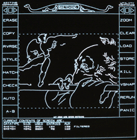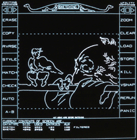

Established in 1900 by the family of Charles Goodwin Sands (Cornell class of 1890), the Sands Medal is traditionally given for the best undergraduate thesis in one of the three branches of the Cornell University School of Art, Architecture, and Urban Planning. The award is not given every year, and in some years, more than one award is given. I was awarded the medal for my Bachelor of Architecture thesis [1]. The thesis describes a computer animation system for line art, based on user-guided interpolation between hand-drawn keyframes. My advisor was Donald Greenberg.
My system was based on the pioneering work of Nestor Burtnyk and Marceli Wein [2], but updated to run on a more modern real-time vector display (the Evans and Sutherland Picture System). Two screenshots from the system are shown above. They represent two keyframes in an animated movie made by fellow student Jose Gelabert. Since both drawings contain the same number of strokes, the system could interpolate linearly between them, producing a sequence of intermediate drawings. Using Burtnyk and Wein's system, artist Peter Foldes made the award-winning film Hunger (1974).
After completing my thesis, I continued working in this area, leading to a Master of Science in Architecture two years later [3]. This second thesis describes a system for online drawing (or optical scanning) of cartoon drawings, user-guided linear interpolation between these drawings, flooding of enclosed areas in the drawings with color or texture, online painting (or optical scanning) of cartoon backgrounds, and merging together of the drawings and backgrounds to create composite frames of an animation sequence. My advisor once again was Don Greenberg.
Although many components of the system described in my Master's thesis were inspired by contemporary work being done by Alvy Ray Smith and Ed Catmull at the New York Institute of Technology [4], my system incorporated a number of new elements. First, the area flooding algorithm (equivalent to the paint bucket in Adobe Photoshop) was particularly efficient [5]. Second, the merging step permitted independent geometric transformation of each artwork layer, with the goal of simulating Walt Disney's multiplane camera, and it included an interactive program for positioning these layers in three dimensions [6]. This merging system is further described in Bruce Wallace's SIGGRAPH 1981 paper [7], his Master's thesis [8], and a paper I wrote for a small European conference [9].
Finally, although mine was not the first paint program to incorporate a simulated airbrush [10], it may have been the first to incorporate a weighted, mask-driven tinting brush. My Master's thesis also contained the first published description of such a brush. This description, together with a resurrection of Alvy Ray Smith's 1978 paint program, was used to prove the existence of prior art in Adobe v. Quantel (1996), a highly publicized trial in which Quantel claimed (falsely) to have invented the computer airbrush, which Adobe uses in Photoshop.
After the completion of my Master's thesis, Don Greenberg and I tried to convince the Walt Disney's feature animation group to incorporate computer graphics into their production process. Unfortunately, several of the "nine old men", who had worked for Disney since the 1930's, were still active, and they would have none if it. By the mid-1980's, these gentlemen had all retired, and Pixar was able to convince Disney to explore the new technology. The system they co-developed was called CAPS (Computer Animation Production System). It ultimately won them an academy award in 1992 for its use in Beauty and the Beast.
Although we were unsuccessful at Disney, we managed to convince Hanna-Barbera Productions to employ our system in the television animation market. Hanna-Barbera was on the verge of closing down domestic production due to spiraling labor costs, and they saw our system as a way to forestall doing this. The animator's union didn't believe them, nor did they relish the prospect of computerization, leading to a bitter strike in 1982. In the end, the animators learned to use our system, which remained in production until 1996. At its peak in the late 80's, one third of Hanna-Barbera's yearly domestic production went through our system, including The Flintstones, Scooby-Doo, and other shows. Ultimately, domestic labor costs become too high even for the computerized production line, and the system was sold to James Wang Films of Taiwan. They ported it to PCs and marketed it for several years under the name Animaster. The original technical team at Hanna-Barbera Productions consisted of myself, Bruce Wallace, Chris Odgers, Bennett Leeds, Jim Mahoney, Steve McDaniel, and Tim Victor. Our chief power user from the production side of the company was Ann Tucker. Interestingly, Ann subsequently went to work for Disney, becoming their chief power user as well.
[1] Levoy, M., A Computer-Assisted Keyfame Animation System. Bachelor's thesis, Cornell University, 1976.
[2] Burtnyk, N., Wein, M., Computer Generated Key-Frame Animation, J. SMPTE, 80(3), March, 1971, pp. 149-153.
[3] Levoy, M., Computer-Assisted Cartoon Animation. Master's thesis, Cornell University, 1978.
[4] Catmull E., The problems of computer-assisted animation, Proc. ACM SIGGRAPH '78, pp. 348-353.
[5] Levoy, M., Area Flooding Algorithms, SIGGRAPH '81 Two-Dimensional Computer Animation course notes, Dallas, Texas, August, ACM, 1981, pp. 6-12. With corrections made in 1982.
[6] Levoy, M., A Computer Animation System Based on the Multiplane Technique, Proc. ACM SIGGRAPH '77, Vol. 11, No. 2, San Jose, California, July, 1977, pp. 65-71.
[7] Wallace, B.A., Merging and Transformation of Raster Images for Cartoon Animation, Proc. ACM SIGGRAPH '81, Vol 15, No. 3, 1981, ACM, pp. 253-262.
[8] Wallace, B.A., Automated production techniques in cartoon animation. Master's thesis, Cornell University, 1982.
[9] Levoy, M., The Design And Implementation of a Large-Scale Computer-Assisted Cartoon Animation System, Proc. Datorgrafikdagar conference, Linkoping, Sweden, June, 1983.
[10] Smith, A.R., Paint, Technical Memo 7, New York Institute of Technology, July 20, 1978. Also issued as tutorial notes at SIGGRAPHs 1978-1982.